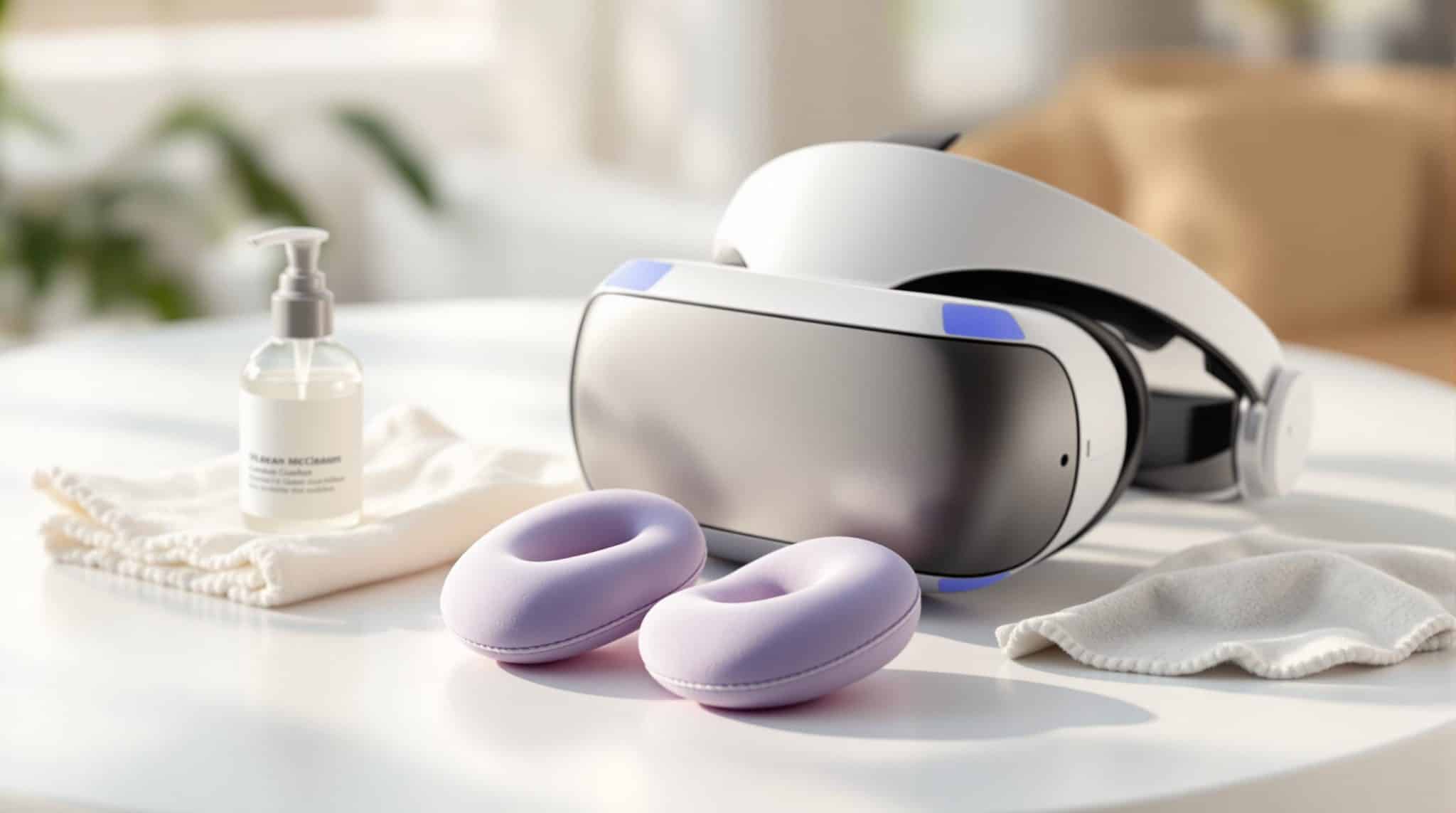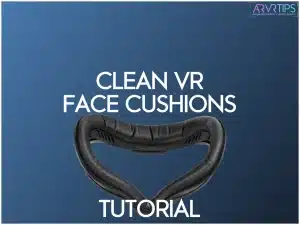Keeping your VR face cushions clean is essential for hygiene and extending your headset’s life. Sweat, oils, and bacteria can quickly build up, leading to odors and skin issues. In this guide, I’ll show you exactly how to clean VR face cushions the right way.
Quick Summary
Here’s a quick guide to cleaning VR cushions effectively:
- Daily Maintenance: Wipe with a microfiber cloth or alcohol-free antibacterial wipes after each use.
- Deep Cleaning:
- Foam Cushions: Use mild soap with a damp cloth; avoid soaking.
- PU Leather Cushions: Clean with a damp cloth and mild detergent; dry immediately.
- Drying: Always air dry at room temperature – no direct sunlight or heat sources.
- Shared Devices: Use disposable covers or sanitize before switching users.
Is There a Difference Between a VR Face Cushion, Facial Interface, and Face Cover?
No, a VR face cushion, facial interface, and face cover are all the exact same thing! These terms can be used interchangeably, and I will switch between all three throughout this article.

How To Clean Your VR Headset Without Ruining It
Getting Ready to Clean
Before you start cleaning, it is important to prepare correctly to protect your VR headset and face cushions. A little prep work goes a long way in ensuring your gear stays in good shape.
Prepare Your VR Headset
Start by removing the facial interface, including detachable face shields and straps. The way you remove these parts depends on your headset. For instance, the Meta Quest 3‘s facial interface can be gently pulled off, while other models might have release buttons or clips.
Once everything is detached, take a moment to determine the material of your face cushions. Most VR headsets use foam, PU leather, or memory foam. Knowing the material helps you choose the right cleaning method and avoid accidental damage.
| Material Type | Characteristics | Example Headsets |
|---|---|---|
| Foam | Soft, porous texture | HTC Vive original cushions |
| PU Leather | Smooth, less breathable surface | Meta Quest 3 facial interface |
| Memory Foam | Dense, shape-retaining material | Aftermarket VR covers |
Collect Cleaning Supplies
Here’s what you’ll need:
- Gentle cleaning tools: microfiber cloths, non-alcohol antibacterial wipes
- Mild liquid soap
- Clean water: room temperature is best
- Nitrile gloves (optional for hygiene)
Avoid alcohol-based or abrasive cleaners, as they can damage your headset’s materials. Also, keep liquids away from the electronic parts.
Now that you’re set up, you can start cleaning your VR headset based on the type of cushion material you have.
Cleaning Steps by Material
Now that you’ve got your supplies ready, let’s go over how to clean VR face cushions based on their material. The cleaning method you choose will depend on the type of cushion and how much care it needs.
Basic Cleaning for All Materials
Start with a soft microfiber cloth to gently wipe away surface dirt, sweat, and oils. If you need a deeper clean, use alcohol-free antibacterial wipes, but ensure the material doesn’t get too damp. This simple routine helps maintain hygiene and prolongs the lifespan of your VR cushions.
| Cleaning Level | Frequency | Tools Needed |
|---|---|---|
| Quick Clean | After each use | Microfiber cloth |
| Basic Clean | Daily/Weekly | Alcohol-free antibacterial wipes |
| Deep Clean | Monthly/As needed | Material-specific cleaning tools |
For more intensive cleaning, follow the material-specific instructions below to avoid damaging your cushions. A bleach mixture is a good option to wash the facial interface down. However, use a diluted mixture so that you don’t stain anything.
Deep Cleaning Foam Cushions
Foam cushions are highly absorbent and require gentle handling to prevent bacteria buildup. Here’s how to clean them deeply:
- Mix mild soap with cold water.
- Lightly dampen a cloth with the soapy solution (don’t soak it).
- Carefully wipe the foam to remove dirt and oils.
- Use a separate damp cloth to remove soap residue, then pat dry with a microfiber cloth.
Remember that soaking foam or using harsh cleaners can ruin the material.
Deep Cleaning PU Leather Cushions
PU leather cushions, such as those on the Meta Quest 3, are water-resistant but still need proper care to avoid wear and tear. Follow these steps:
- Detach the facial interface from your headset.
- Use a damp microfiber cloth dipped in cool water and a small amount of mild detergent to clean the surface in gentle circular motions.
- Wipe any soap residue with a clean, damp cloth and dry immediately with another microfiber cloth.
Avoid over-wetting the material to preserve its durability.
After Cleaning: Care and Maintenance
Drying the Cushions
Let your cushions air dry in a well-ventilated area at room temperature. Avoid placing them in direct sunlight, near heat sources, or in humid spaces, as these conditions can harm the material or encourage bacteria growth. Ensure the cushions are completely dry before reattaching them to your headset. Depending on the material and ventilation, this process might take several hours.
Press a clean microfiber cloth gently against the surface to check if they’re dry. If the cloth stays dry, the cushions are ready to use.
Set a Cleaning Schedule
Keeping a regular cleaning schedule helps maintain hygiene and extends the life of your VR face cushions. Here’s a quick guide based on how often you use your device:
| Usage Level | Cleaning Frequency | Method |
|---|---|---|
| Daily Use | After each session | Quick wipe with a microfiber cloth |
| Regular Use (2-3x/week) | Weekly deep clean | Follow the material-specific cleaning guide |
| Shared Device | Before user switch | Sanitize with alcohol-free wipes |
Meta Quest users should pay extra attention to their facial interfaces, as regular upkeep helps maintain their water-resistant features.
Extra Hygiene Tips
For a cleaner and more comfortable VR experience:
- Clean your face with an antibacterial wipe before using the headset to reduce oil and bacteria transfer.
- If you share your VR headset with friends and family, consider using silicone covers or disposable face shields. These options simplify cleaning and protect the original cushions from wear.
“Using disposable covers or alternative face shields can enhance hygiene by reducing the accumulation of sweat and bacteria on the face cushions. These options can also make cleaning easier and more efficient.”
Store your headset in a dry, ventilated area to avoid moisture buildup. By sticking to these care tips, you can keep your VR headset clean and comfortable for every session.
Conclusion
Keeping your VR face cushions clean is crucial for maintaining their quality and ensuring a safe, enjoyable experience. Regular care and proper cleaning methods can help extend the life of your VR equipment.
Studies show that surfaces like plastic, often found in VR headsets, can retain viruses for up to 72 hours. This makes consistent cleaning even more critical. To clean effectively, it’s essential to understand your cushion’s material and choose appropriate cleaning methods.
Always refer to the manufacturer’s instructions to protect your headset’s water-resistant features. Routine maintenance keeps your gear in top shape and ensures a more hygienic and comfortable experience for all users.


